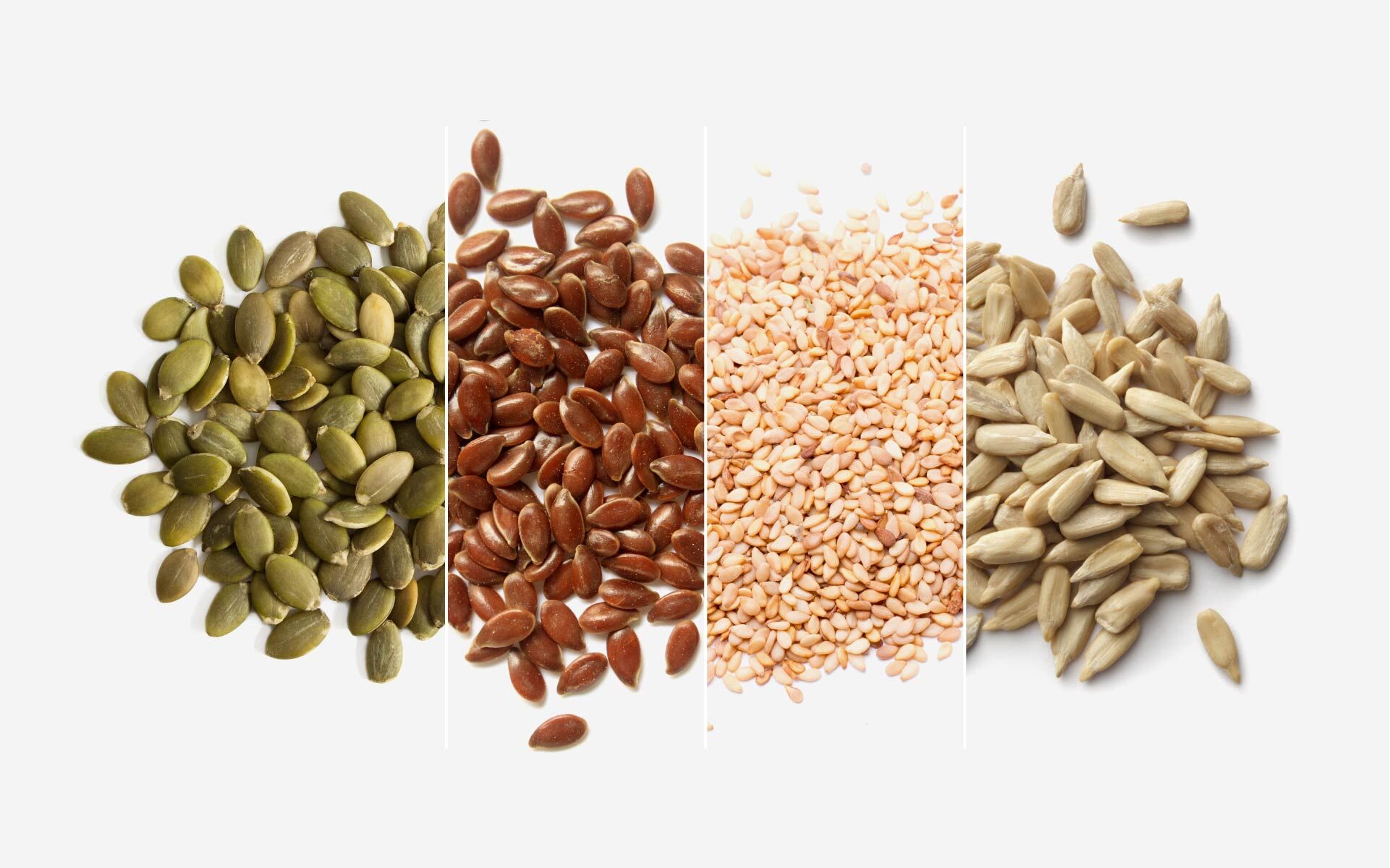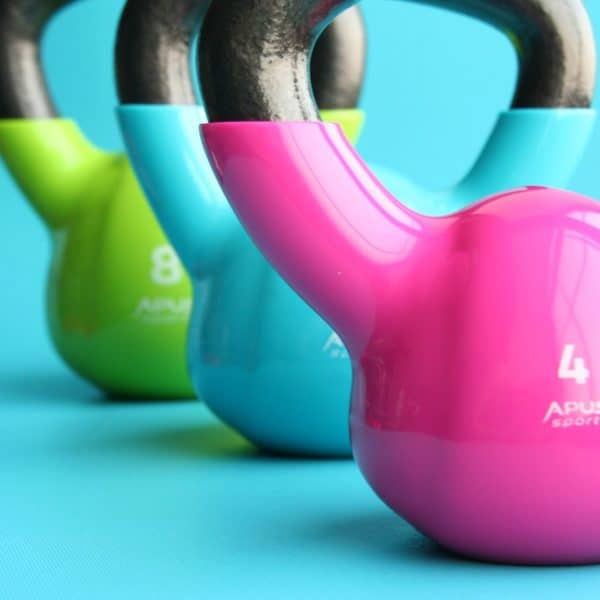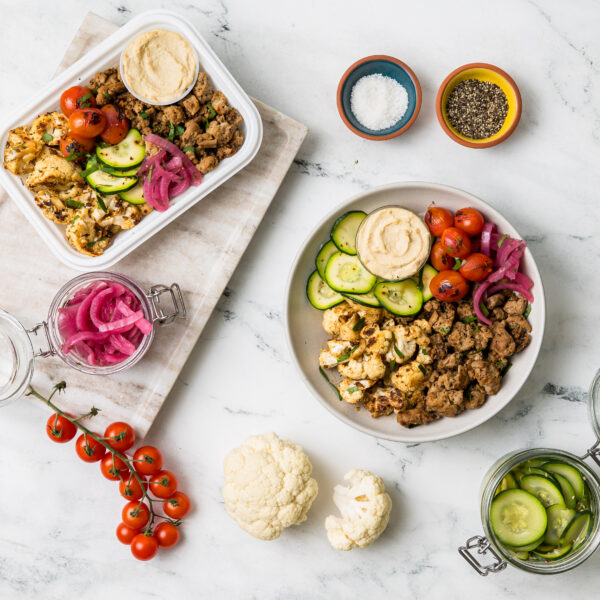Your hormones are vital to your body’s everyday function. While hormones are best known for their role in the menstrual cycle, they also have an impact on mood, skin health, energy and even your hunger & fullness levels. Unbalanced hormones are the root cause of many issues women face today such as Polycystic Ovary Syndrome (PCOS), endometriosis, amenorrhea and ovarian cysts. Seed cycling provides a low-cost and natural way to balance hormones and reduce symptoms associated with these common menstrual disorders. Below we break down everything you need to know about the science behind seed cycling and how to implement the practice into your daily life for better hormone health.
What is seed cycling?
Seed cycling is the ritual of incorporating various seeds into your meals during specific phases of your menstrual cycle. These seeds help to balance your body’s natural hormonal rhythms. Estrogen, the sex hormone responsible for puberty and reproduction, rises during the first half of your cycle and progesterone, the steroid hormone that helps to prepare your uterus for a potential pregnancy after ovulation, rises during the second half. By incorporating foods that encourage hormonal fluctuation, women have found reduced breast pain, more regularity in their cycles and a decrease of symptoms that often occur throughout their cycle.
How does seed cycling work?
Seed cycling works by giving your body the nutrition it needs to function properly throughout every phase of your cycle. While there hasn’t been much research on the relationship of seed cycling to improved levels of hormones in women, there has been plenty of research that shows how specific nutrients present in seeds can help balance hormones in women with a variety of issues.
For instance, research shows that flax seeds can help to lengthen the luteal phase of your menstrual cycle which helps to improve ovulation and PMS symptoms such as cramping and breast pain. Pumpkin and sesame seeds contain zinc, which has been proven to increase the body’s ability to produce progesterone and therefore thicken the walls of the uterine lining.
Many women have found that seed cycling is a cost-effective, all-natural way to help their body function at it’s very best. When done consistently, seed cycling can help improve PMS, sleeping patterns, anxiety, depression, fertility and even bring about periods in those who tend to have irregular cycles or none at all.
Seed Cycling: Getting Started
In order to get started with seed cycling, it’s important to make sure you are familiar with your own cycle. When you’re aware of your body’s own natural rhythms, you’ll be able to decide if seed cycling is right for you and you can also identify the areas where you’d like to see improvement. If you are currently coming off of hormonal birth control or struggling with symptoms of post-birth control syndrome-like acne or irregular periods, seed cycling can be particularly helpful.
Once you’ve decided if seed cycling is right for your body, you might be asking how to do it. Below we break down what to eat during each phase of your cycle, the benefits of each seed and what’s happening in your body during each phase.
Follicular Phase
The follicular phase is the first stage of the menstrual cycle, as your body gets stimulated to produce and release an egg. This phase begins on the first day of your period and ends during ovulation, lasting anywhere from 11–27 days (with an average duration of 14 days). During this phase estrogen levels are at an all-time high, so your diet should be focused on foods that support these levels and prepare your body for an eventual progesterone release.
Pumpkin and flax seeds are key to boosting and balancing estrogen levels in the body, and 1–2 tablespoons of freshly ground seeds should be eaten every day.
- Pumpkin Seeds:
- Zinc for progesterone production, a key element released during the second phase of your cycle.
- Flax Seeds:
- Contain the protective compound lignans which bind to estrogen, aiding in estrogen release from the body throughout the follicular phase.
Below are a few additional tips you can implement during your follicular phase:
- Eat foods rich in vitamin E, like avocado and red bell pepper, to nourish the body.
- High-energy workouts can help to sweat out toxins and reduce PMS.
- The omega–3 present in grass-fed beef and fatty fish can help to regulate hormones during this phase.
Luteal Phase
The second half of your cycle is known as the luteal phase, which begins after ovulation. The average luteal phase lasts 12–14 days, and rounds out your body’s full 28-day menstrual cycle. Progesterone begins to release during this phase, which thickens the lining of your uterine wall so that a fertilized egg can implant itself. If you do not get pregnant during this time, your progesterone levels will drop and the uterine lining will shed.
Since a shorter luteal phase prevents the uterine lining from growing, it’s important to give your body the nutrients it needs to complete the full luteal phase (whether or not you’re trying to get pregnant). 1–2 tablespoons of ground sunflower and sesame seeds should be consumed during each day of the second half of your cycle to increase progesterone levels.
- Sesame seeds:
- Omega–6 fatty acids help your body regulate hormone levels.
- Sunflower Seeds:
- Selenium aids in the function of the liver, and helps to rid the body of excess estrogen.
Below are a few additional tips you can implement during your follicular phase:
- Eat grounding foods like root veggies to help calm the body.
- Walking and restorative yoga classes can help to alleviate symptoms and decrease stress.
- Avoid high sugar and processed carbs to aid in hormone balance.
How to Seed Cycle
Seed cycling for three months has been shown to help regulate irregular cycles, lessen mood swings, reduce PMS and decrease the symptoms associated with conditions like PCOS and endometriosis. Of course, all bodies are different, so it may take some people a longer amount of time to see the benefits of this practice. Having said that, the nutrient content of pumpkin, flax, sesame and sunflower seeds can benefit everyone, no matter their medical history or cycle length.
To get started with seed cycling, begin on day one of your menstrual cycle. If your cycle is completely irregular, start seed cycling on a new moon and follow a traditional cycling schedule to help get your body back on track.
There are a variety of ways to add these seeds to your everyday meals. Grinding the seeds beforehand helps ensure proper absorption, but is only required for sesame seeds (as the body has a hard time breaking down the outer shell during digestion). Grinding also allows you to add the seeds to a variety of smoothies and baked goods without worrying about a change in texture. Whole seeds can also be eaten alone as a snack, or as a topper on your favorite salad, pasta or in a yogurt bowl. You can choose to eat the nut butter varieties of these seeds for the same benefits and more variety, but make sure you choose options without added oils or sugar.
No matter how you choose to eat them, it’s important to get 1–2 tablespoons of each seed every day of your cycle. Check out the infographic below for a handy chart of what seeds to eat when, as well as expert tips for optimizing your cycle.

High-quality food has the potential to nourish your body and correct issues brought on by chronic stress, poor diet and a variety of other factors. Outside of eating a well-rounded diet rich in a variety of whole foods, seed cycling is a great practice to try if you are looking to balance your hormones.
Take the guesswork (and the prep!) out of healthy eating with our meal plans. Add on some pumpkin seeds or Jilz crackers to make your seed cycling journey even easier, or pick up a pumpkin seed snack pack next time you hop in for a quick bite.
Sources: The Chalkboard Mag | Holistic Health Herbalist





Leave a Reply
2 Comments
thanks this was helpful
Thank you so much, Sam!